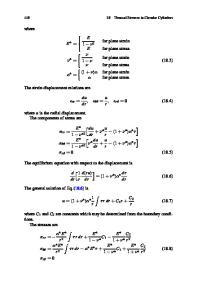Thermal analysis in swirl motion of Maxwell nanofluid over a rotating circular cylinder
- PDF / 626,160 Bytes
- 14 Pages / 595.28 x 841.89 pts (A4) Page_size
- 29 Downloads / 303 Views
APPLIED MATHEMATICS AND MECHANICS (ENGLISH EDITION) https://doi.org/10.1007/s10483-020-2643-7
Thermal analysis in swirl motion of Maxwell nanofluid over a rotating circular cylinder∗ A. AHMED1 , M. KHAN1 ,
J. AHMED1,2,†
1. Department of Mathematics, Quaid-i-Azam University, Islamabad 44000, Pakistan; 2. Department of Basic Sciences, University of Engineering and Technology, Taxila 47050, Pakistan (Received Feb. 24, 2020 / Revised May 23, 2020) Abstract In this paper, the mechanism of thermal energy transport in swirling flow of the Maxwell nanofluid induced by a stretchable rotating cylinder is studied. The rotation of the cylinder is kept constant in order to avoid the induced axially secondary flow. Further, the novel features of heat generation/absorption, thermal radiation, and Joule heating are studied to control the rate of heat transfer. The effects of Brownian and thermophoretic forces exerted by the Maxwell nanofluid to the transport of thermal energy are investigated by utilizing an effective model for the nanofluid proposed by Buongiorno. The whole physical problem of fluid flow and thermal energy transport is modelled in the form of partial differential equations (PDEs) and transformed into nonlinear ordinary differential equations (ODEs) with the help of the suitable flow ansatz. Numerically acquired results through the technique bvp4c are reported graphically with physical explanation. Graphical analysis reveals that there is higher transport of heat energy in the Maxwell nanoliquid for a constant wall temperature (CWT) as compared with the prescribed surface temperature (PST). Both thermophoretic and Brownian forces enhance the thermal energy transport in the flowing Maxwell nanofluid. Moreover, the temperature distribution increases with increasing values of the radiation parameter and the Eckert number. It is also noted that an increase in Reynolds number reduces the penetration depth, and as a result the flow and transport of energy occur only near the surface of the cylinder. Key words Maxwell nanofluid, rotating cylinder, heat source/sink, Joule heating, convective condition, numerical solution Chinese Library Classification O361 2010 Mathematics Subject Classification
76R05, 76E07, 76A05
Nomenclature α, B, B0 , C,
stretching rate (T−1 ); magnetic field; strength of magnetic field (N·m·A−1 ); concentration in fluid;
Cw , Re, Sh, T,
wall concentration; Reynolds number; Sherwood number; temperature of fluid (K);
∗ Citation: AHMED, A., KHAN, M., and AHMED, J. Thermal analysis in swirl motion of Maxwell nanofluid over a rotating circular cylinder. Applied Mathematics and Mechanics (English Edition), 41(9), 1417–1430 (2020) https://doi.org/10.1007/s10483-020-2643-7 † Corresponding author, E-mail: [email protected] c ⃝Shanghai University and Springer-Verlag GmbH Germany, part of Springer Nature 2020
1418
A. AHMED, M. KHAN, and J. AHMED
Tw , T∞ , C∞ , cp , DB , DT , E, Ec1 , Ec2 , f ′, f (η) , η 1/2 g, ht , Le, M, Nt , Nb , N u, P r, Q0 , r,
1
wall temperature (K); ambient fluid temperature (K); ambient c
Data Loading...











